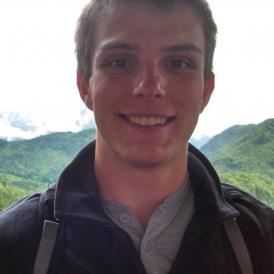
Christian Richardson (BE ’16) wasn’t planning to go to college. Originally from Grand Junction, Colorado, Richardson had dreamed of jumping out of planes and rescuing people as a pararescueman. It wasn’t until his junior year, after discovering the field of Biological Engineering, when he decided he wanted to pursue a degree. “I’ve always wanted to help people,” says Richardson. He feels now, however, that he’ll have an even greater impact developing medical treatments than administering them. Richardson chose MIT because of the Biological Engineering Department. “In Course 20, we look at biology as an engineering field,” shares Richardson. “It’s not like other schools’ departments where it’s engineering as it applies to biology.”
A self-claimed life-long science nerd and inventor, Richardson grew up making super soakers, watermelon trebuchets and hover cars from scraps lying around the house from his dad’s electrical company. It’s not a huge leap to see why he loves being on MIT’s iGEM team (International Genetically Engineered Machine), which will compete in October in the world’s largest gathering of synthetic biologists to date. With over 2,500 Synthetic Biology researchers from 245 universities across 32 countries, the iGEM competition showcases student teams who attempt to solve real-world problems by building genetically engineered biological systems with standard, interchangeable parts from the Registry of Standard Biological Parts.
iGEM began at MIT, in January of 2003, in a month-long IAP course in which students designed biological systems to make cells blink. Over the past decade, the competition has grown and iGEM is now a Cambridge-based non-profit organization. MIT’s team this year has eleven undergraduates on it, six of them are BE students – Kathryn Brink, Eric Ersland, Alexa Garcia, Raymond Liu, Jiaqi Xie and Christian Richardson. The group is comprised of mostly freshmen, which puts them as one of the youngest teams in the competition. In spring 2014, the MIT iGEM team was selected and they have been working tirelessly all summer with their leaders, Professor Ron Weiss, Research Associate Jonathan Babb and post-doc Brian Teague.
In the past, iGEM teams have taken on projects ranging from a rainbow of pigmented bacteria to banana and wintergreen smelling bacteria, an arsenic biosensor, Bactoblood and buoyant bacteria. This year’s team is tackling Alzheimer’s disease. “We felt is was the most feasible project that was well-characterized and we sort of understood how it worked. There were relatively clear targets and we felt our project could have a real impact,” shares Richardson. Using synthetic signaling pathways, the team is detecting two unique characteristics of the disease in the brain: toxic protein aggregates outside the cell and Alzheimer's-specific levels of molecules inside the cell. Once the disease characteristics are detected, enzymes are produced to break down the toxic protein, thereby alleviating its effect.
“This has been a very challenging experience,” reflects Richardson. “More than half of the team has never been in a lab before, so we’re really learning how to do science. We got thrown into the deep end.” Unlike a typical UROP, the team has the opportunity to pick their own research project and then go through all of the stages with it. “We have real ownership over this project,” Richardson shares. “We’re acquiring tons of lab skills.” Post-doc Brian Teague is really excited about the project this year. “The undergraduates have chosen a topic with real-world impact -- a problem that affects an enormous number of people. They are taking a really unique, novel approach to solving it. As a scientist, it's exciting, and as a mentor it's really rewarding. I'm really proud of how they are all developing as scientists -- ultimately that's the point."
Richardson is proud of his work, too. “I spent 6-to-7 weeks this summer cloning B-cell receptors,” states Richardson. “Progress was not really tangible and our sub-group had lots of parts. We were not sure we got the pieces right. When we finally did some microscopy, we were hoping to see some halos around the cells and we saw these beautiful pristine halo images. It was really rewarding to get it right on the first try.”
Like most MIT iGEM teams, the group is more interested in the research than the competition. That being said, they are pleased with the feedback they’ve received so far about their project. Richardson feels that “we blew them out of the water” at the NEGEM (northeast regional) jamboree earlier this summer. “We were the only team doing mammalian cells; very few people know how to do them because they are complicated systems and you need a lot of infrastructure to be able to do the research.”
With the support of the BE Communication Lab, the iGEM team will soon begin thinking about how best to present their work in a poster and a presentation at the final competition in late October. “The team is really committed this year,” shares Richardson. “Many of the team members are already thinking about how they can continue to do their B-cell receptor work as a group after the competition ends.”
“I’ve never had such an intense experience, in which I am rapidly acquiring new skills; I’m really living the research life,” reflects Richardson. Being on this team has made Richardson feel like he wants to pursue working in industry, where he can make “real tangible products.” Being at MIT, with such a strong start-up culture, has also made Richardson consider a future as a biological engineer entrepreneur. “I never really thought about considering a start-up company before coming to MIT, but there is so much support and structure here to help make that happen. MIT feels like the best place to be.”
For more information on iGEM and the upcoming competition, check out: http://2014.igem.org/


